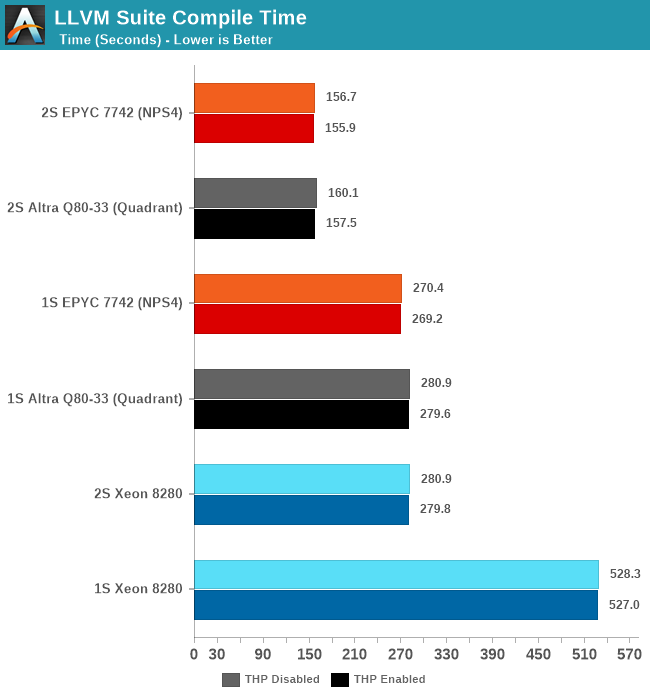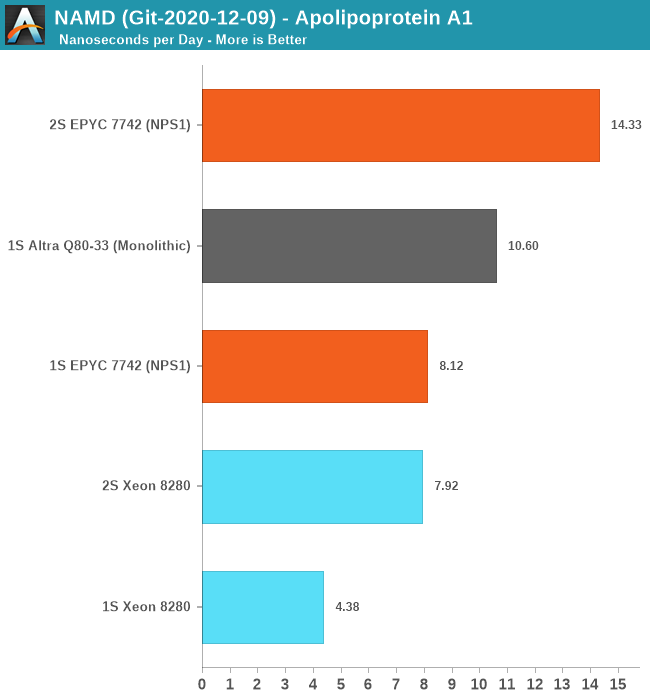The Ampere Altra Review: 2x 80 Cores Arm Server Performance Monster
by Andrei Frumusanu on December 18, 2020 6:00 AM EST- Posted in
- Servers
- Neoverse N1
- Ampere
- Altra
Compiling LLVM, NAMD Performance
As we’re trying to rebuild our server test suite piece by piece – and there’s still a lot of work go ahead to get a good representative “real world” set of workloads, one more highly desired benchmark amongst readers was a more realistic compilation suite. Chrome and LLVM codebases being the most requested, I landed on LLVM as it’s fairly easy to set up and straightforward.
git clone https://github.com/llvm/llvm-project.gitcd llvm-projectgit checkout release/11.xmkdir ./buildcd ..mkdir llvm-project-tmpfssudo mount -t tmpfs -o size=10G,mode=1777 tmpfs ./llvm-project-tmpfscp -r llvm-project/* llvm-project-tmpfscd ./llvm-project-tmpfs/buildcmake -G Ninja \ -DLLVM_ENABLE_PROJECTS="clang;libcxx;libcxxabi;lldb;compiler-rt;lld" \ -DCMAKE_BUILD_TYPE=Release ../llvmtime cmake --build .We’re using the LLVM 11.0.0 release as the build target version, and we’re compiling Clang, libc++abi, LLDB, Compiler-RT and LLD using GCC 10.2 (self-compiled). To avoid any concerns about I/O we’re building things on a ramdisk – on a 4KB page system 5GB should be sufficient but on the Altra’s 64KB system it used up to 9.5GB, including the source directory. We’re measuring the actual build time and don’t include the configuration phase as usually in the real world that doesn’t happen repeatedly.

The Altra Q80-33 here performs admirably and pretty much matches the AMD EPYC 7742 both in 1S and 2S configurations. There isn’t exact perfect scaling between sockets because this being a actual build process, it also includes linking phases which are mostly single-threaded performance bound.
Generally, it’s interesting to see that the Altra here fares better than in the SPEC 502.gcc_r MT test – pointing out that real codebases might not be quite as demanding as the 502 reference source files, including a more diverse number of smaller files and objects that are being compiled concurrently.
NAMD
Another rather popular benchmark tool that we’ve actually seen being used by vendors such as AMD in their marketing materials when showcasing HPC performance for their server chips is NAMD. This actually quite an interesting adventure in terms of compiling the tool for AArch64 as essentially there little to no proper support for it. I’ve used the latest source drop, essentially the 2.15alpha / 3.0alpha tree, and compiled it from scratch on GCC 10.2 using the platform’s respective -march and -mtune targets.
For the Xeon 8280 – I did not use the AVX512 back-end for practical reasons: The code which introduces an AVX512 algorithm and was contributed by Intel engineers to NAMD has no portability to compilers other than ICC. Beyond this being a code-path that has no relation with the “normal” CPU algorithm – the reliance on ICC is something that definitely made me raise my eyebrows. It’s a whole other discussion topic on having a benchmark with real-world performance and the balance of having an actual fair and balanced apple to apples comparison. It’s something to revisit in the future as I invest more time into looking the code and see if I can port it to GCC or LLVM.

For the single-socket numbers – we’re using the multicore variant of the tool which has predictable scaling across a single NUMA node. Here, the Ampere Altra Q80-33 performed amazingly well and managed to outperform the AMD EPYC 7742 by 30% - signifying this is mostly a compute-bound workload that scales well with actual cores.
For the 2S figures, using the multicore binaries results in undeterministic performance – the Altra here regressed to 2ns/day and the EPYC system also crashed down to 4ns/day – oddly enough the Xeon system had absolutely no issue in running this properly as it had excellent performance scaling and actually outperforms the MPI version. The 2S EPYC scales well with the MPI version of the benchmark, as expected.
Unfortunately, I wasn’t able to compile an MPI version of NAMD for AArch64 as the codebase kept running into issues and it had no properly maintained build target for this. In general, I felt like I was amongst the first people to ever attempt this, even though there are some resources to attempt to help out on this.
I also tried running Blender on the Altra system but that ended up with so many headaches I had to abandon the idea – on CentOS there were only some really old build packages available in the repository. Building Blender from source on AArch64 with all of its dependencies ends up in a plethora of software packages which simply assume you’re running on x86 and rely on basic SSE intrinsics – easy enough to fix that in the makefiles, but then I hit some other compilation errors after which I lost my patience. Fedora Linux seemed to be the only distribution offering an up-to-date build package for Blender – but I stopped short of reinstalling the OS just to benchmark Blender.
So, while AArch64 has made great strides in the past few years – and the software situation might be quite good for server workloads, it’s not all rosy and we’re still have ways to go before it can be considered a first-class citizen in the software ecosystem. Hopefully Apple’s introduction of Apple Silicon Macs will accelerate the Arm software ecosystem.










148 Comments
View All Comments
Brane2 - Saturday, December 19, 2020 - link
Meh. Nothing special. it has been benchmarked on Phoronix and it performed more or less on par with Rome. 80 newest ARM cores against 64 mature x86 cores within constrained power envelope.Naples is just about to come out and I suspect some time after that AMD will have something like really wide new RISC-V cores.
Wilco1 - Saturday, December 19, 2020 - link
It won most benchmarks on Phoronix while using significantly less power. Yes Milan is about to be released, and it will have to compete with the 128-core Altra Max. Which do you believe is going to win - 64 SMT cores or 128 real cores?mode_13h - Sunday, December 20, 2020 - link
It actually won less than half of the benchmarks on phoronix, since a number of those graphs just re-state the results in score/W. There are also questions over some of the compiler options used on those benchmarks, since many of the tests are compiled with options that won't enable AVX on benchmarks where it should be beneficial (yet, not having SVE, the N1 cores are at no such disadvantage).Wilco1 - Monday, December 21, 2020 - link
"should be beneficial" -> "might help in a few limited cases". AVX/AVX512 isn't that useful for general C/C++ code. You typically only see large gains when people optimize using intrinsics.mode_13h - Monday, December 21, 2020 - link
Intrinsics don't compile if they're for a CPU arch beyond what the compiler is being instructed to target. So, even packages where people take the time to optimize with intrinsics need to guard them with compile-time checks to ensure the CPU target is capable of executing those instructions.Compilers do generate vectorized code. I don't know how well GCC is doing on that front, lately, but the TNN tests should be a good way to see that. Too bad those tests don't use -march=native.
What's interesting about TNN is I'm looking at the exact source revision Phoronix is using, and it seems they've completely dropped their backend for x86. The source/tnn/device/x86/ is simply missing. So, I wonder if they decided the compiler was good enough that they didn't need to bother with their own hand-optimized code for it, or if they just decided they don't care how fast their stuff runs on it.
See:
* https://openbenchmarking.org/innhold/83a730ed41d4e...
* https://github.com/Tencent/TNN/tree/v0.2.3
Wilco1 - Monday, December 21, 2020 - link
TNN does not benefit from -march=native. Phoronix uses the generic C++ version which doesn't benefit from vectorization. Try it yourself.Optimized versions using intrinsics typically use runtime checks so you automatically get the fastest version that works on your CPU. The makefile selects the right ISA variant for any files using intrinsics. But none of this is used in the TNN test.
mode_13h - Monday, December 21, 2020 - link
> TNN does not benefit from -march=native. Phoronix uses the generic C++ version which doesn't benefit from vectorization. Try it yourself.At this point, I probably will.
> Optimized versions using intrinsics typically use runtime checks so you automatically get the fastest version that works on your CPU.
That's a whole additional level of effort for the developers. For them to bother compiling and conditionally calling different versions only makes sense if they think their main userbase aren't going to bother recompiling specifically for their hardware. In the case of specialized packages, it's reasonable to expect your users to take a little trouble for the best performance. It's really things like very low-level libs or multimedia code where you tend to see the sort of elaborate runtime detection and dynamic codepath selection that you're describing.
mode_13h - Monday, December 21, 2020 - link
I think Basis Universal and High Performance Conjugate Gradient are some other cases where the wider SIMD of Zen2 and Skylake-SP should confer significant benefit.Wilco1 - Monday, December 21, 2020 - link
"should give significant benefit" -> "might give some benefit". I suggest you try out. Autovectorization is not nearly as good as you seem to believe, and the overall speedup is often disappointing even if some loops are 10-20x faster.vinayshivakumar - Saturday, December 19, 2020 - link
I am a bit puzzled why none of these processors support SMT... Can someone shed light on why this is the case ?